„Das Leben macht mir keine Angst“
"We are slowly changing the conversation for other generations"
May 21, 2020
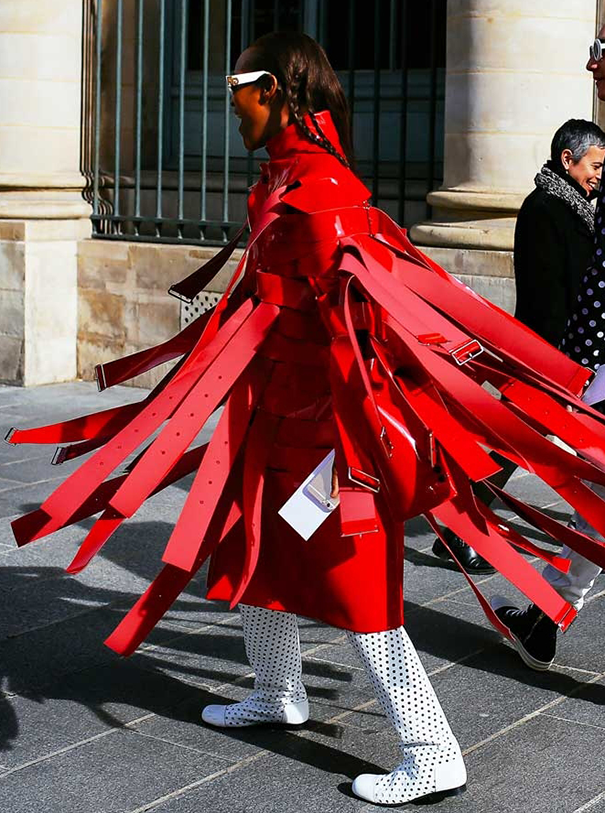
Es war dieser Gegenentwurf zu den Schönheitsidealen der Modewelt, der Michelle Elie geholfen hat sich selbst und ihren Körper zu akzeptieren. In der Ausstellung „Life doesn’t frighten me“ im Museum Angewandte Kunst in Frankfurt, bekommen die Besucher durch über 50 Ensembles der Comme des Garçons Kreationen Einblick in eine Welt der Mode, die Schönheit infrage stellt.
Michelle Elies Ankleidezimmer in einer Kölner Dachgeschosswohnung hat nichts von einem Antiquariat, trotzdem ist sie eine Sammlerin. Michelle Elie, schulterlange Haare, schwarze Haut, ihre Stimme hetzt, ihre Hände fahren ruhig über die Kleider, greift ein Teil nach dem anderen. Da hängt eine Lederweste mit aufgenähten Türgriffen neben einem Kleid mit zwei Schwimmreifen, einer auf Schulter- und einer Hüfthöhe, so zeigt es die Dokumentation TheFashion Teller. Elie lebt in und mit ihren Kleidern, sie sind ihre zweite Haut. In ihr bewegt sie sich selbstsicher und stolz, doch das war nicht immer so.
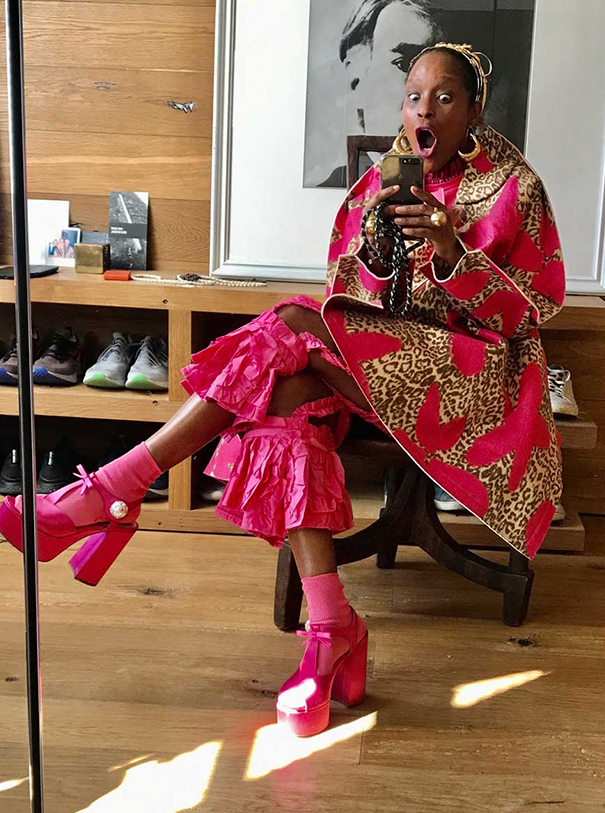
In den 90ern arbeitete Michelle Elie als Model in New York, heute ist sie Schmuckdesignerin in Köln.
Die junge Michelle Elie modelte in New York, obwohl sie nicht den damaligen Modelstandards entsprach. Wann immer sie gebucht wurde, hatte sie Angst, dass ihr abgesagt wurde aufgrund ihrer Größe und Breite – sie hatte immer Probleme mit ihren Hüften. Doch 1995, Elie war gerade mit ihrem ersten Kind schwanger und ihr Körper veränderte sich, kaufte sie ihr erstes Ensemble von Comme des Garçons aus der Frühjahrskollektion „Body Meets Dress, Dress meets Body“. Dieses Kleidungsstück war es, das all die Jahre des Kampfes mit ihrem Körper beendete: „Ich habe immer mit mir gekämpft und plötzlich war es ok Hüften und einen Bauch zu haben“, hört man Elie in der Doku The Fashion Teller aus dem Off sagen.

Zu der Pariser Fashion Week reist Elie gern mal aus Köln mit dem Auto an. Und ihre unzähligen Looks für die Tage? Die verpackt sie selber. @Stela Alves.
Die Doku gibt einen Vorgeschmack darauf, was nun auch persönlich in der Ausstellung „Life doesn’t frighten me“ im Frankfurter Museum Angewandte Kunst zu erleben ist. Das Lebensmotto der Sammlerin hat es zum Titel der Ausstellung geschafft und ihre Sammlung in die Ausstellungsräume. Bis zum 30. August 2020 wird die Ausstellung unter strengen Hygienevorschriften für das Publikum zugänglich sein. Über 50 Ensembles der Comme des Garçons Kreationen aus dem Archiv Elies geben exklusive Einblicke in die außergewöhnliche Welt der Haute Couture des Labels Comme des Garçons. Die Modedesignerin Rei Kawakubo gründete 1969 in Tokio das Label unter dem Schlachtruf „So wie Jungen“. Durch Dekonstruktion und Zerstörung ohne Rücksicht auf Körperformen, bricht Kawakubo nicht nur mit den Konventionen der Schnittkunst, sondern auch mit den durch westliche Schönheitsideale gelenkten Blick. Comme des Garçons ist die Antithese zur Schönheitsnorm in einer weißen Mehrheitsgesellschaft.
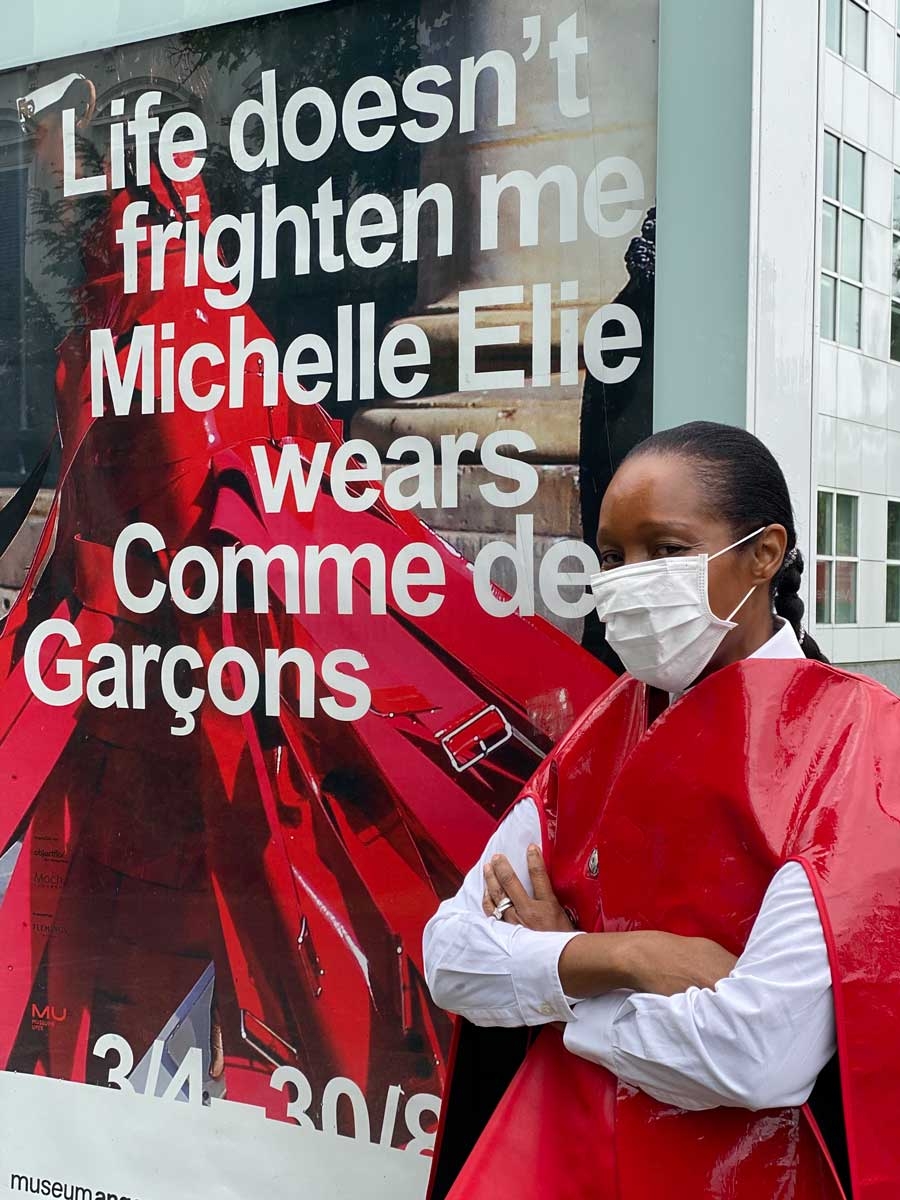
Dass das Lebensmotto der Sammlerin zum Ausstellungstitel wird, stand von Anfang an fest.
Doch die Ausstellung „Life doesn’t frighten me“, kuratiert von Dr. Mahret Ifeoma Kupka, widmet sich nicht nur Mode und kritischen Schönheitsnormen, sondern stellt sich auch die Frage der Repräsentation. Die Wahl für schwarze Mannequins in der kompletten Ausstellung wurde ganz bewusst getroffen. Zum einen sind sie ein Abbild Elies zum anderen kontern sie die Unterrepräsentation von schwarzen Menschen und BIPoC (Black/ Indigenous People of Color) in Geschichte und Gegenwart der Mode- und Kunstwelt. Michelle Elie wurde in Haiti geboren und wanderte mit ihrer Familie nach New York aus, studierte International Studies und arbeitete als Model. Heute lebt die Schmuckdesignerin in Köln. Wir haben mit Michelle Elie über Mut und Mode gesprochen.
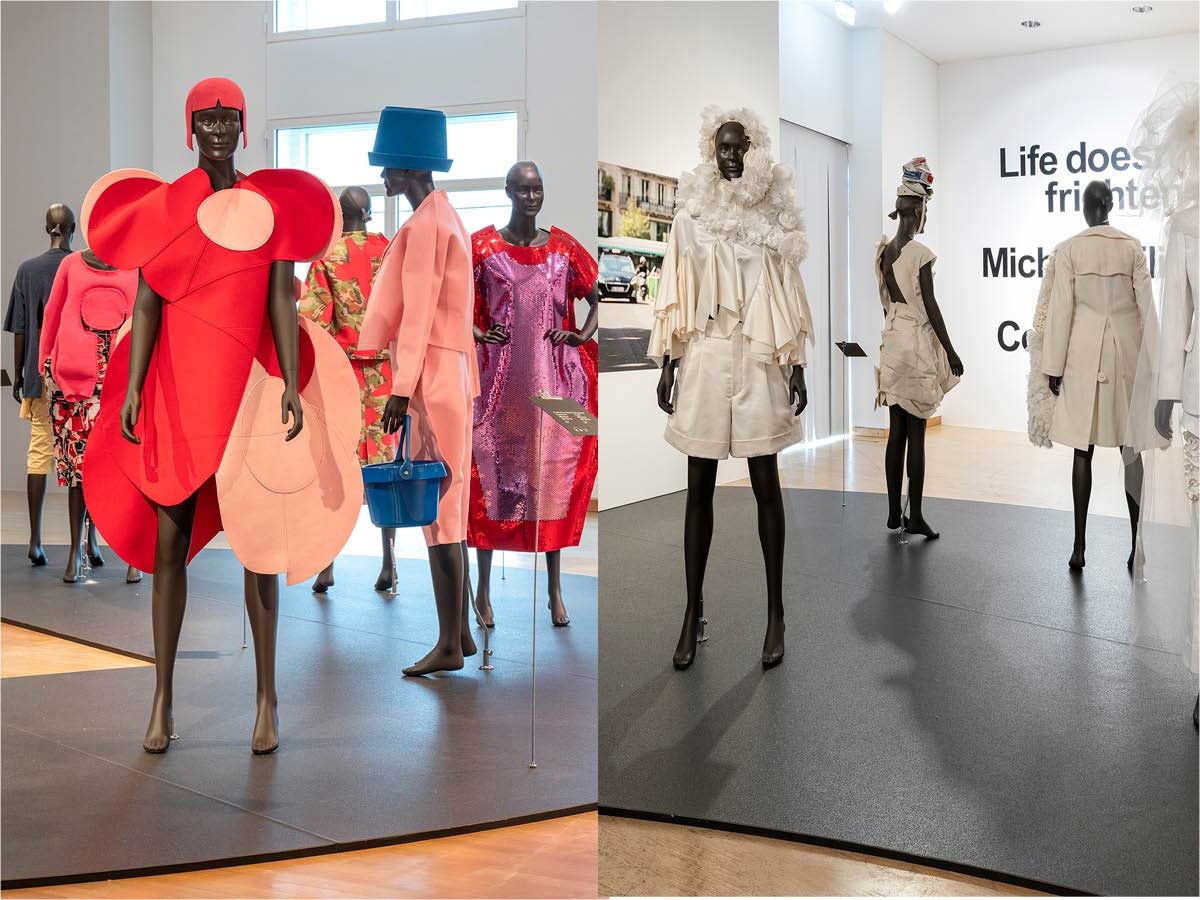
Die Ausstellung zeigt über 50 Ensembles der Comme des Garçons Kreationen aus dem Archiv Elies und wurde kuratiert von Dr. Mahret Ifeoma.
Achtung: How long does it take you to get dressed in the morning?
Michelle Elie: Five minutes, my hair takes longer.
A: Wearing these extravagant outfits in public also requires courage, you will constantly attract attention, are there also days when you are not brave and do not want to attract attention?
ME: It is true that the piece does create attention but in a good way. You see, that maybe the viewer has not seen clothes made of this sort of shape and forms. So, there is a sense of surprise glance and after there is fascination which develops into a curiosity. I find that great because there is an invisible interaction with the viewer. I’m always brave but there are days that I do not have the energy to explain myself and my clothing. It is either you get it or you don’t. Those kinds of days I rather avoid crowded places or events where fashion is not celebrated or creativity is not recognised.

Michelle Elie fordert Schönheit heraus und öffnet einen neuen Dialog über Schönheit. @Phill Taylor.
A: The exhibition not only focuses on your extensive collections, but also on the lack of representation of black people and BIPoC in the fashion and art world. How should this representation look best and what went wrong so far, especially in fashion?
ME: Representation was never there from the very beginning. If we search in the history book and trace our heritage in the western world, it is pretty horrific and crazy. Now if you look in places such as schools, books, museums for representation you will think that we actually only existed as slaves. I couldn’t find paintings of people of my skin colour in those incredible paintings I studied in art classes and the school trips to the museums – nor paintings done by black artists.
We were made to believe that we did not have these qualities and so there was no representation of any kind. So, I grew up believing this was normal and I accepted it. Now if we go into fashion, the same was done. The fashion pages or the advertisements were not including black models until the last years more and more. I mean, we had Naomi Sims, then came Iman, Naomi Campbell and Liya Kebede. The few others are stars, actressses or from the music field. Always one girl for 20 years until they found another girl for the next 10 years and so on….
I think that fashion is supposed to be democratic but in reality, it is not. Everyone loves and wears fashion, why not allow them in the representation. Through this act of including other races, we are slowly changing the conversation for other generations coming up.

Die schwarzen Mannequins sollen auch der Unterrepräsentation von schwarzen Menschen und BIPoC in Geschichte und Gegenwart der Mode- und Kunstwelt kontern.
AD: When you think of the Michelle Elie, who used to model in New York and was confronted with the beauty ideals of a white majority society, what would you like to say to her today?
ME: The Michelle Elie that grew up in NYC, and the model as well, was the best part of learning the game and had to find another way to be part of conversation. Since I was born in Haiti with both Haitian parents as my mentors, I always knew that I did not fit into particular ideas of beauty but rather I had to work hard and do more than my best to achieve what I want to achieve for myself. The standard was even higher for us because we were Haitians. So to go back to your original question: “Michelle, behind mountains there are other mountains.” Which means, there are always challenges. Even if you conquer one, there will be others. Therefore, learn to climb your mountains and conquer them.
AD: What should visitors to the exhibition pay particular attention to? Do you have a favorite piece?
ME: I think the visitors will feel nothing but pure joy and beauty when they realise that this is actually someone’s wardrobe. They most likely will start to imagine where this person lives, when she wears these clothes and as well, what people think of her when she is walking around. They will have all these questions and then they might compare themselves with the clothes and think: “Wow! She must have a lot of courage and be fearless to wear these incredible, beautiful, and poetic clothes. She must have a lot of fun wearing her wardrobe.”
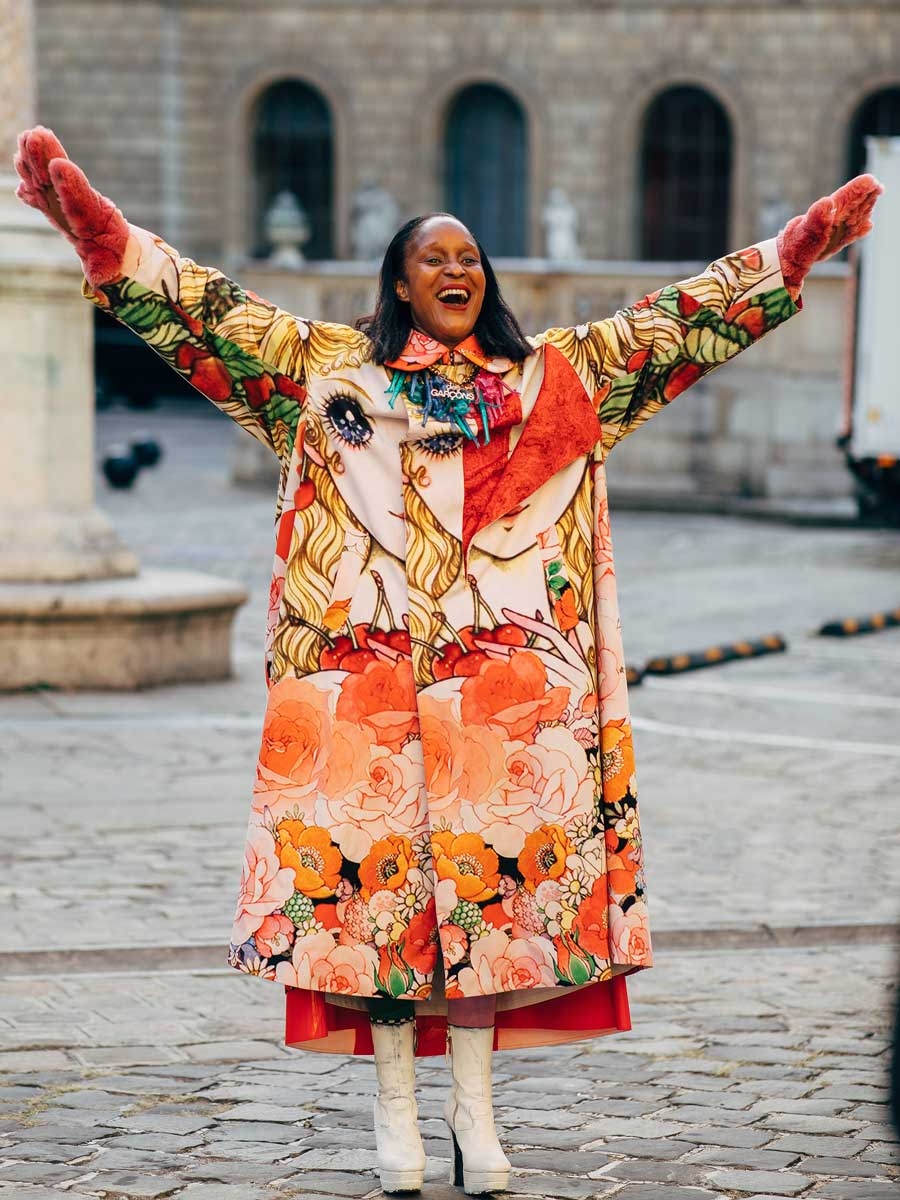
“Life doesn’t frighten me” – Michelle Elie lebt und trägt ihr Lebensmotto. @Acielle.


